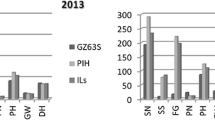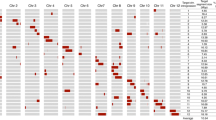Abstract
The nearly isogenic nature of the introgression lines (ILs) provides a relative advantage over other segregating populations in the rapid implementation of pyramiding approach through crosses and marker analysis. A set of 126 ILs carrying various introgressed segments from a presumed wild progenitor, Oryza rufipogon Griff. Acc. W1944 in the background of an elite Korea japonica cultivar (O. sativa L.), Hwayeongbyeo, was constructed using the marker assisted selection (MAS) technique combined with repeated backcrosses. The 126 ILs have different W1944 segments on each chromosome, with 100% coverage of wild segments on chromosome 1, while for chromosome 10, the coverage was only 33.3%. The mean number of homozygous and heterozygous donor segments were 3 (ranging from 0 to 7) and 4.7 (ranging from 1 to 14.5), respectively, and 31.6% of introgressed segments had sizes of less than 10.5 cM. A total of 41 quantitative trait loci (QTLs) and two loci associated with pericarp coloration were identified. The number of QTLs per trait ranged from 2 to 6. Phenotypic variance associated with each QTL varied from 9.1 to 52.2%, with an average of 17.1%. For 11 (26.8%) of the QTLs detected in this study, the O. rufipogon-derived alleles contributed the desired agronomic effect despite the overall inferior characteristics of the wild phenotype. Favorable alleles from the O. rufipogon accession were identified for panicle number, panicle length, days to heading, secondary branches, spikelets per panicle, and 1,000-grain weight.
Similar content being viewed by others
References
Ashikari M, Sakakibara H, Lin SY, Yamamoto T, Takashi T, Nishimura A, Angeles ER, Qian Q, Kitano H, Matsuoka M. 2005. Cytokinin oxidase regulates rice grain production. Science 309: 741–745
Bennett MD, Leitch IJ. 2005. Nuclear DNA amounts in angiosperms: progress, problems, and prospects. Ann. Bot. (Lond.) 95: 45–90
Cai HW, Morishima H. 2000. Genomic regions affecting seed shattering and seed dormancy in rice. Theor. Appl. Genet. 100: 840–846
Cai HW, Morishima H. 2002. QTL clusters reflect character associations in wild and cultivated rice. Theor. Appl. Genet. 104: 1217–1228
Causse MA, Fulton TM, Cho YG, Ahn SN, Chunwongse J, Wu K, Xiao J, Yu Z, Ronald PC, Harrington SC, Second G, McCouch SR, Tanksley SD. 1994. Saturated molecular map of the rice genome based on an interspecific backcross popu lation. Genetics 138: 1251–1274
Cho YG, Eun MY, McCouch SR, Chae YA. 1994. The semi dwarf gene, sd-1, of rice (Oryza sativa L.). II. Molecular mapping and marker-assisted selection. Theor. Appl. Genet. 89: 54–59
Devos KM. 2005. Updating the “crop circle”. Curr. Opin. Plant Biol. 8, 155–162
Doi K, Iwata N, Yoshimura A. 1997. The construction of chro mosome introgression lines of African rice (Oryza glaberrima Steud.) in the background of japonica (O. sativa L.). Rice Genet. Newsl. 14: 39–41
Eshed Y, Zamir D. 1994. Introgressions from Lycopersicon pen nellii can improve the soluble-solids yield of tomato hybrids. Theor. Appl. Genet. 88: 891–897
Fan CH, Xing YZ, Mao HL, Lu TT, Han B, Xu CG, Li XH, Zhang QF. 2006. GS3, a major QTL for grain length and weight and minor QTL for grain width and thickness in rice, encodes a putative transmembrane protein. Theor. Appl. Genet. 112: 1164–1171
Gur A, Zamir D. 2004. Unused natural variation can lift yield barriers in plant breeding. PLOS Biology 2: 1610–1615.
Ishimaru K.2003. Identification of a locus increasing rice yield and physiological analysis of its function. Plant Physiol. 133: 1083–1090
Kojima S, Takahashi Y, Kobayashi Y, Monna L, Sasaki T, Araki T, Yano M. 2002. Hd3a, a rice ortholog of the Arabidopsis FT gene, promotes transition to flowering down stream of Hd1 under short day conditions. Plant Cell Physiol. 43: 1096–1105
Lee SJ, Oh CS, Suh JP, McCouch SR, Ahn SN. 2005. Identification of QTLs for domestication-related and agro nomic traits in an Oryza sativa × O. rufipogon BC1F7 popu lation. Plant Breed. 124: 209–219
Li CB, Zhou AL, Sang T. 2006. Genetic analysis of rice domes tication syndrome with the wild annual species, Oryza nivara. New Phytol. 170: 185–194
McCouch SR, Teytelman L, Xu YB, Lobos KB, Clare K, Walton M, Fu BY, Maghirang R, Li ZK, Xing YZ, Zhang QF, Kono I, Yano M, Fjellstrom R, DeClerck G, Schneider D, Cartinhour S, Ware D, Stein L. 2002. Development and mapping of 2240 new SSR markers for rice (Oryza sativa L.). DNA Res. 9: 199–207
Nelson JC. 2001. QGene Manual. Electonic address: http://greengenes.cit.cornell.eduport70; directory ’software for genetics/QGene’ (http://www.qgene.org).
Sobrizal, Ikeda K, Sanchez PL, Doi K, Angles ER, Khush GS, Yoshimura A. 1999. Development of Oryza glumaepatula introgression line in rice, O. sativa L. Rice Genet. Newsl. 16: 107–108
Temnykh S, Cartinhour S, Park W, Ayres N, Hauck N, Lipovich L, Cho YG, McCouch SR. 2000. Mapping and genome orga nization of microsatellite sequences in rice (Oryza sativa L.). Theor. Appl. Genet. 100: 697–712
Tian F, Li DJ, Fu Q, Zhu Z, Fu YC, Wang XK, Sun CQ. 2005. Construction of introgression lines carrying wild rice (Oryza rufipogon Griff.) segments in cultivated rice (Oryza sativa L.) background and characterization of introgressed segments associated with yield-related traits. Theor. Appl. Genet. 112: 570–580
Weng JF, Gu SH, Wan XY, Gao H, Guo T, Su N, Lei CL, Zhang X, Cheng ZJ, Guo XP, Wang JL, Jiang L, Zhai HQ, Wan JM. 2008. Isolation and initial characterization of GW5, a major QTL associated with rice grain width and weight. Cell Res. 18: 1199–1209
Xiao J, Li J, Grandillo S, Ahn SN, Yuan L, Tanksley SD, McCouch SR. 1998. Identification of tait-improving quantita tive trait loci alleles from a wild rice relative, Oryza rufi pogon. Genetics 150: 899–909
Xiong LZ, Liu KD, Dai XK, Xu CG, Zhang Q. 1999. Identification of genetic factors controlling domestication-related traits of rice using an F2 population of a cross between Oryza sativa and O. rufipogon. Theor. Appl. Genet. 98: 243–251.
Yano M, Sasaki T. 1997. Genetic and molecular dissection of quantitative traits in rice. Plant Mol. Biol. 35: 145–153
Yano M, Katayose Y, Ashikari M, Yamanouchi U, Monna L, Fuse T, Baba T, Yamamoto K, Umehara Y, Nagamura Y, Sasaki T. 2000. Hd1, a major photoperiod sensitivity quanti tative trait locus in rice, is closely related to the Arabidopsis flowering time gene CONSTANS. Plant Cell 12: 2473–2484
Yano M. 2001. Genetic and molecular dissection of naturally occurring variation. Curr. Opin. Plant Biol. 4: 130–135
Author information
Authors and Affiliations
Corresponding author
Rights and permissions
About this article
Cite this article
Yuan, PR., Kim, HJ., Chen, QH. et al. QTL dissection of agronomic and domestication traits using introgression lines carrying wild rice (Oryza rufipogon Griff.) segments in cultivated rice (O. sativa L.) background. J. Crop Sci. Biotechnol. 12, 245–252 (2009). https://doi.org/10.1007/s12892-009-0144-2
Received:
Accepted:
Published:
Issue Date:
DOI: https://doi.org/10.1007/s12892-009-0144-2




